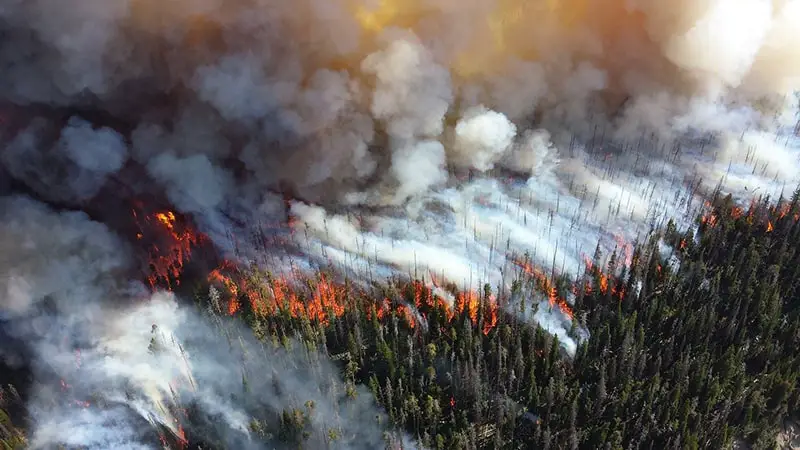Click here to get this post in PDF

Many western areas of the United States and Canada face the risk of wildfires every year between August and November. The National Interagency Fire Center releases monthly updates on the matter for the entire country.
According to the report from August 1st, 2020, this year’s season has started intensively, with fires already present in several states and provinces. Great Basin, northern California, Pacific Northwest, and the northern Rockies are believed to be the most endangered areas. Moreover, professionals predict that any lightning may result in increased fire activity and above-normal fire potential in September 2020.
Small to medium businesses are exposed to risks no matter the time of the year, not to mention the wildfire season. Threats caused by fires may directly affect day-to-day operations, decrease revenue, or increase expenses. The fire’s impact is often severe enough for businesses to fail.
Identifying the potential consequences of the undesired events such as fires in the nearby areas should be of the most significant concern to any entrepreneur running a small to medium business in the western USA and Canada.
To increase the chances of surviving the unfavorable season, professional risk management strategists have come up with several methods of preventing the company from failing during the wildfire season. Here is what your business should start practicing.
Implement a BCMS
In times full of uncertainties, all the small and medium companies must have their business plans well-established and in place. Otherwise, it may turn out that the company won’t be able to work at its full capacity and achieve the set KPI’s. One of the most excellent solutions to ensure business continuity is implementing a comprehensive BC program.
BCMS stands for Business Continuity Management System. It aims to operate, monitor, and improve business processes and procedures to provide business continuity in the most uncertain times.
By introducing such a system, businesses can achieve the set organizational goals and objectives without having to train multiple staff members. Moreover, a BCMS improves reporting processes, making them easier to navigate and faster to generate.
Businesses can gain full resilience using well-thought-out business continuity management software. If you are a small or medium-sized CEO and want to survive the wildfire season without any complications, investing in a BCMS is one of the most reasonable things to do.
Think About the Digital
In the wildfire season, many entrepreneurs think seriously about relocating the company. While changing the place where most sales occur may be a good idea, it doesn’t necessarily have to be done by moving to another physical location.
If the business depends strongly on its location to generate sales, moving outside of the current area may disrupt the organization by negatively affecting the customers, staff members, and supplier access. In the event of a fire, the business may have to shut down for a while, and not restart trading after the wildfire season is over.
However, there is one place that is safe from all the possible natural disasters – the digital world. Changing the stationary shop into an e-commerce store, or upgrading an on-site service into a computerized one, may turn out to be the best possible solution for the small and medium businesses.
Because of that, the business becomes more accessible and gains new potential customers who prefer to get things done online instead of in person. Moreover, in the digital world, there is a possibility to expand internationally much more quickly.
Make Sure You Have the Backups
There are not enough words in the dictionary to express the importance of all kinds of backups.
Backup the Data
When the wildfire season is around the corner, small and medium companies should do the paper documentations and sensitive data backups immediately.
It takes only a couple of minutes for the fire to burn all the papers. If you don’t make sure everything is double-copied and saved in a digital format, you might end up losing all the valuable information forever.
Backup the Supplier
Having a backup supplier might seem like you aren’t loyal to the current supplier, but it is okay to secure your business that way. It may happen that the fires will cut off the access to the road, and the present supplier won’t be able to deliver the necessary equipment to the company.
How does a small or medium company survive then such grim circumstances? By seeking alternative suppliers capable of supplying similar items but from elsewhere in the area.
Backup the Staff
Ensure every employee has his buddy in case of illness or a sudden departure caused by the fires.
Peer buddies should know all about their jobs, systems they operate on, and clients they serve. Pairing up people will prevent your company from being understaffed and increase the productivity of all workers.
Moreover, conducting a workshop on remote working to the staff member might be a great idea, as commuting during the wildfire season may not be the safest.
Conclusion
Wildfire Season comes every year, so the western USA and Canada entrepreneurs should prepare their companies for the possible difficulties well in advance.
Some of the most effective risk management strategies for small and medium-sized businesses include implementing a BCMS, making several backups, and focusing more on the digital world.
It is never guaranteed that the company will survive the unfortunate season. However, by taking those precautions, any business increases the chances of getting through the unpleasant times.
You may also like: How to Find the Right Natural Disaster Insurance Provider for Your Business
Image source: Pixabay.com
